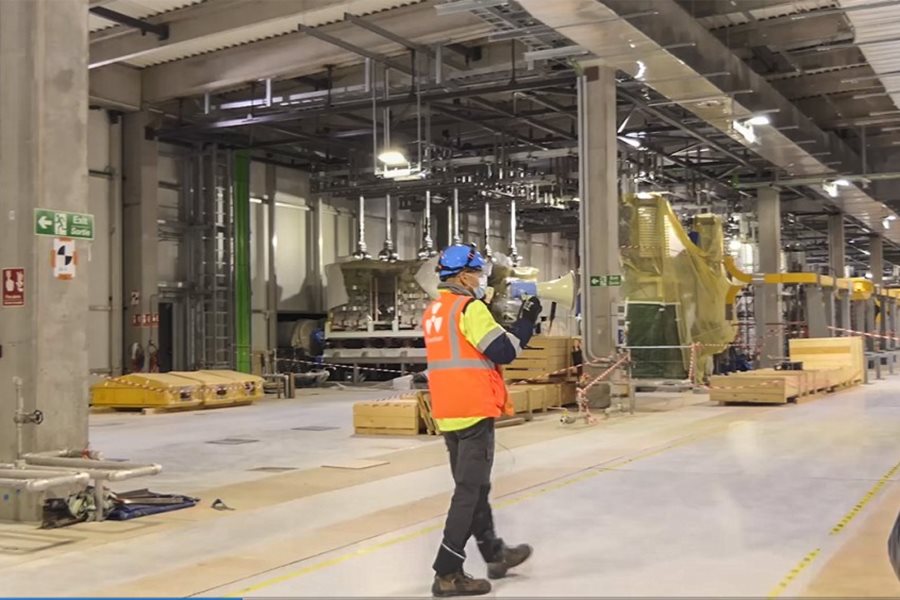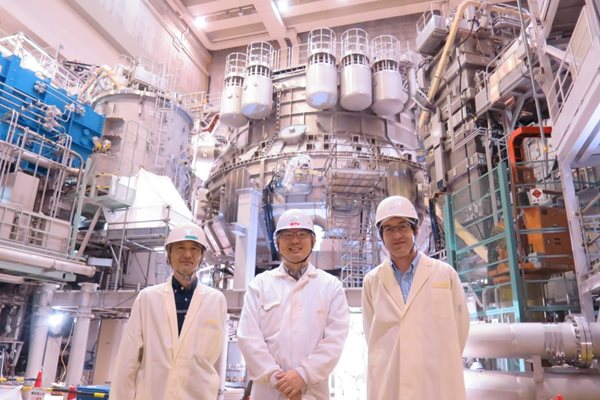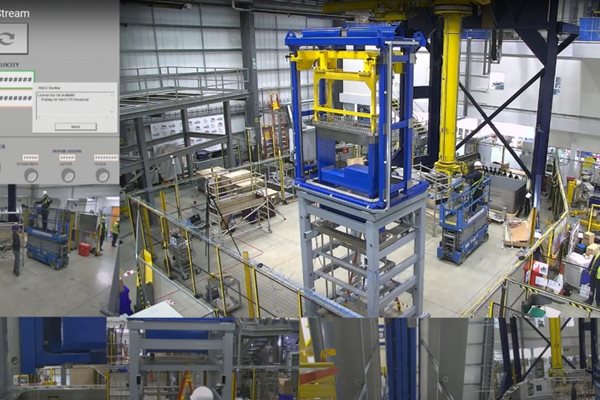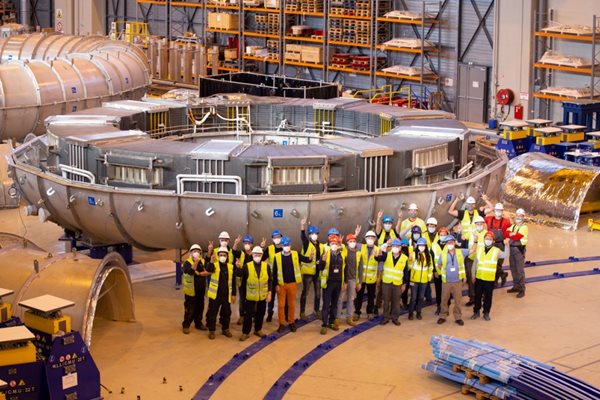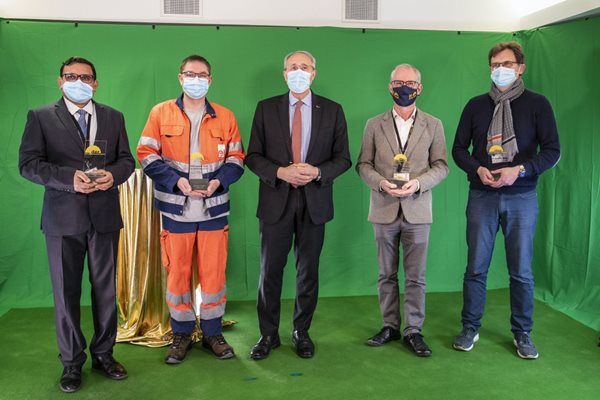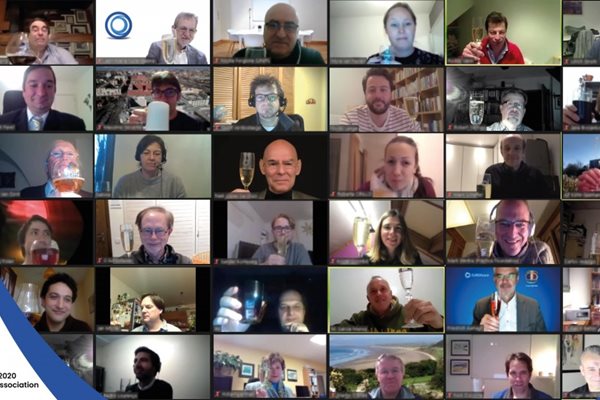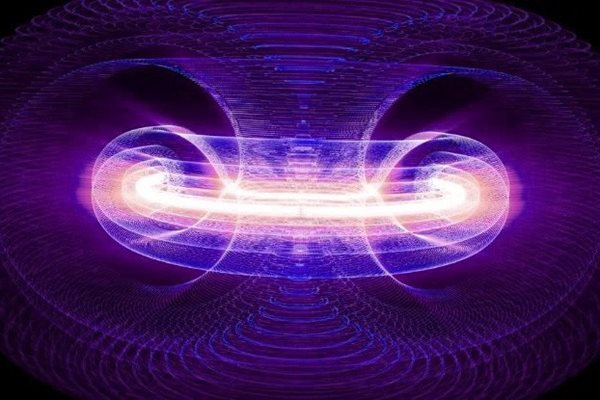
you're currently reading the news digest published from 07 Dec 2020 to 14 Dec 2020
featured7
press14
featured
Video | The ITER you never see
As night falls and the gates close on the ITER construction site, a small group of men and women take over, each tasked with a specific mission. Security agents begin patrolling the premises, checking each and every office in the half-dozen ITER administrative buildings, inspecting storage areas, doing their rounds throughout the sprawling construction site. Night is also the time for radiographic testing, which is used to verify the quality of welds in critical components and assemblies. For safety reasons, operators need to make sure that buildings are empty and that no one stands in the way of the sources that 'see' into the steel. Before dawn, other personnel move in for other activities—premises and equipment need to cleaned and meals need to be prepared. This video gives you a glimpse of the ITER you never see. It would not be complete however without an encounter with the ITER Organization information technology specialists who provide the tools and manage the infrastructure that makes communication possible between the thousands of actors of the ITER Project, both on site and throughout the world, day and night. Click here to view the "ITER you never see" video.
Fusion world | ITER-JT-60SA collaboration in full swing
The ITER Organization is gaining knowledge and experience through active involvement in the commissioning activities underway on the JT-60SA tokamak in Japan. The valuable collaboration is made possible through a trilateral agreement with the partners of the Broader Approach, which is an agreement between Europe and Japan on advanced fusion activities. Under the terms of a trilateral collaboration arrangement signed in November 2019 by the ITER Organization, Japan's QST*, and Fusion for Energy (the European Domestic Agency for ITER), the ITER Organization will directly benefit from the experience gained in fusion activities under the Broader Approach Agreement—and in particular the assembly, installation, integrated commissioning and operation of the tokamak JT-60SA. The Broader Approach activities have been devised to complement ITER in the efforts towards the development of fusion energy. The projects under the Broader Approach are: the satellite tokamak JT-60SA; engineering validation design activities and a full-scale prototype of an accelerator to test new materials (IFMIF/EVEDA); and the International Fusion Energy Research Center (IFERC), which includes the realization and operation of a supercomputer and the implementation of next-phase (DEMO) design and R&D activities. The first collaboration under the trilateral arrangement was launched in 2020, concurrently with the completion of assembly of the JT-60SA tokamak and the start of its integrated commissioning activities. Under the new collaboration, a work program of joint ITER-F4E-QST activities has been defined for 2020/2021 with focus on sharing of experience in the areas of tokamak assembly, system and integrated commissioning, and first plasma operation in JT-60SA. The acquisition of this experience is presently the highest priority for ITER, which began machine assembly this year, with the goal of minimizing risks in the coming years. To that end, ITER staff have been informed of the procedures followed and lessons learned during JT-60SA machine assembly and are actively participating in the integrated commissioning activities presently in progress. While it was originally foreseen that several ITER staff members would be involved in-person at the QST Naka site, due to the COVID-19 restrictions most of the participation had to take place remotely and only one ITER staff member could be present at Naka this year. This notwithstanding, remote collaboration has been effective with ITER staff participating in JT-60SA weekly progress and planning meetings on integrated commissioning activities by teleconference, as well as in specially arranged meetings to share knowledge and experience gained by the JT-60SA team with a wide range of ITER specialists. At this stage, all the magnets have been cooled down to the very low temperatures required for operation (-269 °C) and have reached the superconducting state successfully. In parallel, baking of the tokamak vessel is taking place to achieve the necessary vacuum conditions for plasma operation. The breadth and depth of the collaboration will expand over the coming year as first plasma is achieved and initial operation up to a plasma current 2.5 MA is demonstrated.C It is becoming increasingly clear that the knowledge and experience shared during the present phase of the JT-60SA program represents a unique opportunity for the ITER staff to refine plans for ITER's First Plasma phase, which includes integrated commissioning, First Plasma demonstration and operation of the ITER magnets to the nominal currents required for 15 MA plasmas. Soon after, from 2023 onwards, the IO-F4E-QST collaboration on the basis of the JT-60SA Research Plan will support the optimization of the ITER Research Plan and thus contribute to the achievement of ITER's fusion power production goals in the most effective way. *QST = Japan's National Institutes for Quantum and Radiological Science and Technology
Test blanket modules | Test facility confirms remote handling approach
The extremely challenging remote maintenance operations planned for ITER require that engineers and system owners plan and rehearse for them now. In the latest set of trials run for ITER at the UK Atomic Energy Authority's RACE facility, teams successfully demonstrated the remote handling replacement of ITER's test blanket modules that will be performed in the ITER Hot Cell. As a first-of-a-kind fusion reactor, ITER will be facing a number of unprecedented challenges in the remote handling and maintenance of novel, multi-tonne components in hostile environments with little or no direct viewing. A partnership between the ITER Organization and RACE (Remote Applications in Challenging Environments) is helping the ITER remote handling team and systems owners to test whether component designs are well matched with the maintenance capabilities of the project before the manufacturing process is initiated, so that costly rework at a later date can be avoided. 'We think of RACE as our off-site mockup facility,' says remote handling engineer David Hamilton. 'Carrying out a task through remote handling is necessarily more clumsy and crude than if it were carried out by hand. We need to ensure that the designs of the components have suitable features, and that the remote handling job can be done; for this, there is nothing better than practicing with a full-scale mockup in conditions similar to what we are expecting.' RACE has already concluded a task on the maintainability of the ITER equatorial diagnostic port plugs and implementing agreements are underway relating to the remote maintenance of the vacuum vessel pressure suppression system, the feasibility of cutting and welding diagnostic first wall cooling pipes, the remote handling of vacuum flanges, synthetic viewing, and the precise tensioning of bolts by robotic tools. In late November/early December, the RACE team held final mockup trials demonstrating the remote handling replacement of ITER test blanket modules. Two of ITER's equatorial (mid-plane) port plugs will host tritium breeding blanket mockups called test blanket modules (TBMs). The modules are drawer-like structures situated at the plasma end of the port plugs, and each plug will host two. The remote handling replacement of the TBM sets is scheduled during every long-term maintenance period during fusion operation at ITER, or approximately every two years, making the TBM port plugs Remote Handling Class 1 components. 'A lot of R&D has gone into this replacement operation to ensure that it can be done regularly and reliably,' says mechanical responsible officer Byoung Yoon Kim from the Tritium Breeding Blanket Section. 'With RACE, we're getting to see our ideas in action.' To carry out the mockup trials, the RACE team designed and built the mockups of a TBM set and of a TBM frame according to ITER specifications—a process that has already generated valuable feedback about component design. These mockups faithfully reproduce the size and weight of the actual components, their centre of gravity, and all interfacing features and tolerances. An external guiding system—the solution for ensuring that the TBM sets can be inserted without touching the sides of the port plugs along a trajectory of more than 2 metres from the back of the port plug to the front—is also an important part of the demonstration of remote handling feasibility. 'When it's time to refurbish the ITER test blanket modules, the TBM port plugs will be removed from the machine during maintenance and delivered (in a horizontal position) to the ITER Hot Cell Facility. In the Hot Cell, they will be raised to vertical for the TBM set replacement activity,' says Kim. 'At RACE, we are testing the tools and the protocol of this highly precise replacement operation with full-scale physical mockups. It's invaluable.' Over two weeks, the ITER team witnessed the TBM port plug mockup demonstration trials by video conference and live stream. 'This is the first of the RACE trials that we have not been able to witness in person because of the Covid-related restrictions,' regrets Hamilton. 'It's not ideal, but we are all making the best of it.' The first two days were dedicated to the critical remote handling operation, with particular attention to the precision of the guiding system. The detailed processes and results of the trial are summarized as follows: the 3-tonne guiding system (height of about 3 metres) was successfully positioned and fixed with the flange of the TBM set mockup (8 tonnes); the guiding system with the TBM set mockup (with a total weight of 11 tonnes) was successfully lifted and positioned into the four holes of TBM frame mockup; the lowering of the TBM set mockup was successfully carried out with sub-millimetre precision over more than 2 metres. A number of auxiliary tasks were performed, such as the replacement of the vacuum seal, the positioning of cover plates, the bolting of the TBM set flange, the leak testing of the vacuum seal, and post inspection after dismantling. 'Useful suggestions have been made throughout the process, including the definition of requirements phase, the design phase for the mockups and tools, fabrication and testing,' says Kim. 'These suggestions relating to the remote handling compatibility of the component designs will be incorporated as we move forward for the final design of TBM port plug.' 'The feedback from these trials drives improvements both to the remote maintainability of the component and the Hot Cell remote handling tooling,' adds Hamilton. 'The mockup structures will later be transferred to the ITER on-site mockup facilities where they can be used for ongoing trials and training of personnel using the actual remote handling equipment and tools.'
Fabrication | Bottom ring magnet completes all testing
Poloidal field coil #6—the bottommost ring coil of the ITER machine and the first in line for installation—has completed all testing on site in the European winding facility. Poloidal field coil #6 (PF6) is a 400-tonne magnet, the heaviest in a series of six ring magnets that will be installed outside of the vacuum vessel and toroidal field coil superstructure to influence the shape of the plasma and contribute to its stability by "pinching" it away from the walls. Under an agreement signed with the European Domestic Agency Fusion for Energy, responsible for this ring magnet and four others, PF6 was fabricated by the Institute of Plasma Physics, Chinese Academy of Sciences (ASIPP). Fusion for Energy and ASIPP teams have been collaborating since 2016 on the fabrication, from qualification activities, to pancake winding and impregnation, successful factory acceptance testing, and finally transport to the ITER site. The final fabrication step was thermal testing in the on-site European Poloidal Field Coils Winding Facility verify how the magnet responds under thermal contraction generated by ultra-cold and to conduct global leak, electrical and high voltage tests. During thermal testing, the coil was inserted into a dedicated cryogenic chamber and cooled down to approximately 80 K (-193 °). Three full cooldown and warmup cycles were performed, each one requiring approximately one month. Read the full report on the Fusion for Energy website.
The ITER Awards | Achievement in a year of challenge
On Tuesday 8 December, ITER Director-General Bernard Bigot hosted a celebration to pay tribute to the dedication and achievements of ITER staff, contractors, and partners, as well as to the partners and family members who provide constant support. This year's celebration was virtual, by necessity; and in recognition of the long, strange journey that has been the Year 2020—with its peculiar hardships and unique triumphs—the Director-General chose this year to launch the ITER Awards. Reflecting on the milestones reached and challenges overcome, four categories were chosen: First-of-a-Kind Component, Balance-of-Plant System, Installation and Assembly Sequence, and Best Support During the COVID-19 Pandemic. The ITER staff were asked to submit nominations for teams in each area; within a week, nearly 120 nominations had been received. These were consolidated, with seven candidates per category, and put to a vote. The winners were announced during the Tuesday evening celebration. The Director-General presented a representative of each winning team with a polished ingot of ITER Grade F316 stainless steel surmounted by a lucite plate bearing the ITER logo and the declaration, 'You are the star makers.' For the First-of-a-Kind Component award, the winner was the cryostat manufacturing and production team, in recognition of the completion of the cryostat lower cylinder and upper cylinder, as well as the completion of all cryostat lid elements. For the Balance-of-Plant Systems award, the winner was the Tokamak Assembly Preparation Building construction team, in recognition of having largely completed this building to nuclear specifications in a 9-month period. For the Installation and Assembly Sequence award, the winner was the team of mobile crane operators in the Tokamak Complex, in recognition of their successful performance of multiple complex lifting and movement operations with high precision and safety, including the installation of the cryostat base and lower cylinder as well as the initial lifts of vacuum vessel sector 6. For the Best Support During the COVID-19 Pandemic award, the winner was the Information Technology (IT) Division, for providing the infrastructure and innovative solutions to enable the necessary massive shift toward teleworking and digitalization of meetings and processes without loss of performance, using surveys to collect and respond to feedback. As Director-General Bigot put it, the award winners represented only a small fraction of those who deserved for their work to be celebrated. 'I have never been more grateful for all of you—the One-ITER team—than watching your exceptional performance during the extreme challenges we faced this year. Every one of you demonstrated your commitment, whether on the worksite, in the offices, or teleworking. It would be impossible to recognize all of you in a single celebration.' One thing is certain: this is a year we will never forget.
FuseNet | Education network celebrates 10 years
FuseNet, the European fusion education network, has just turned 10. By supporting workshops and events, connecting educators and students, and advertising internship and job opportunities, FuseNet is playing an important role in educating the fusion workforce of the future. 'Education is the most powerful weapon which you can use to change the world.' The former president of South Africa and Nobel Peace Prize winner Nelson Mandela certainly did not specifically have the education of future fusion scientists and engineers on his mind when he spoke these words. But Mandela's message could certainly also apply to the development of a new energy source for mankind. 'As fusion moves towards the commercial era, it is more important than ever that we provide the best possible education to the next generation of fusion scientists and engineers,' said Roddy Vann, Chair of FuseNet on the occasion of the association's 10th anniversary on Wednesday 9 December 2020. A lot of active and former members joined the virtual party, including Niek Lopes Cardozo and Roger Jaspers, both professors at Eindhoven University, and professors emeriti Jean-Marie Noterdaeme and Guido van Oost, together the masterminds behind the idea to create an education network across Europe. Ten years ago, on a cold and overcast December morning, Lopes Cardozo and Jaspers had made their way to an Eindhoven notary to formally establish the FuseNet Association. The moment had already been several years in the making. The FuseNet program initially launched under the flag of the Seventh Framework Programme for Research—the European Union's ambitious research and innovation program. Several fusion professionals had joined in 2007 in an effort to improve fusion education across Europe and to bring together the different fusion education communities that were scattered across the continent. Today FuseNet counts 69 universities and research centres from 25 countries as members, including the ITER Organization. It stimulates and coordinates fusion education Europe-wide and provides the logistics and the funding for internships, educational material, mini workshops and an annual PhD event. In October a new project was born, the European Fusion Teacher Day, which was attended by 600 educators from all over Europe. During the anniversary celebration, a new Memorandum of Understanding was signed between FuseNet and ENEN, the European Nuclear Education Network. And two new Members were officially welcomed on board: the Ruđer Bošković Institute, Croatia, and the National Centre for Scientific Research 'Demokritos' in Greece.
United States | A strategic plan to deliver fusion energy
The US Department of Energy (DOE) Fusion Energy Science Advisory Committee (FESAC) has released a 10-year national strategic plan for fusion energy and plasma science. The report represents the culmination of a community effort that was launched in 2018 and that involved hundreds of scientists from national labs, universities, and private ventures in the United States. Their recommendations—summarized in A Community Plan for Fusion Energy and Discovery Plasma Sciences—were used heavily by the FESAC subcommittee charged with the development of a long-range strategy for the DOE Fusion Energy Sciences program. 'The research community worked hard [...] to convey a wealth of creative ideas and its passion to accelerate fusion energy development and advance plasma science. Their effort culminated in the consensus Community Planning Process report. Our work is based heavily on this report, and we extend our sincere gratitude to our colleagues for their efforts. Following the research community's lead, we worked by consensus in generating this report. Different ideas were listened to and were thoughtfully deliberated until a shared view on each issue emerged. This process allowed us to discuss and appreciate our different points of view and come to consensus language. Ultimately, we speak with one voice in conveying a vision for a vibrant program that will bring significant benefit to society,' wrote the authors of the report. Powering the Future: Fusion & Plasmas sets out a decade-long vision for the field of fusion energy and plasma science, 'presenting a path to a promising future of new scientific discoveries, industrial applications, and ultimately the timely delivery of fusion energy.' It suggests a number of priorities for the US fusion program, including: the establishment of the scientific and technical basis for a fusion pilot plant by the 2040s; the establishment of experimental facilities for fusion materials R&D; the exploration of burning plasma scenarios through participation in ITER; R&D on the challenge of reactor-scale plasma exhaust; investment in innovative techniques and technologies, and; the translation of advances in fusion science and technology into applications that benefit society. Different budget scenarios are also laid out, showing what can be accomplished within the framework of 'constant,' 'modest growth,' and 'unconstrained' fusion program financing. The plan and its recommendations, which were adopted and endorsed during a remote Fusion Energy Sciences Advisory Committee Meeting held on 7, 8, and 10 December 2020, will now serve as advisory input to the FESAC and the DOE Office of Fusion Energy Sciences (FES), which is responsible for all decisions and implementation. For the United States, the plan represents the first long-term strategic roadmap to deliver fusion energy and to advance plasma science. "For the first time, a strategic plan for fusion and plasma research has been created starting with grassroots leadership from the research community,' said Dr Troy Carter, a University of California, Los Angeles physics professor and chair of the FESAC subcommittee. 'The hard work and passion of the community resulted in the unique vision for development of fusion energy and advancement of plasma science expressed in the report.'
